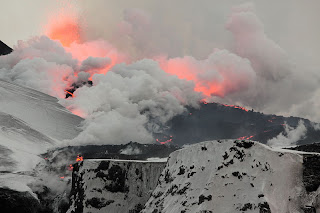 |
| The Mid-Atlantic ridge; a divergent techtonic plate spreads about 2.5 cm per year. (Red triangles show active volcanoes) http://en.wikipedia.org/wiki/File:Iceland_Mid-Atlantic_Ridge_Fig16.gif |
Continuing plate movements, along with the hot spot (a volcanic region beneath the Earth's mantle) under Southern Iceland makes the area high in volcanic activity. The most recent volcanic activity was the eruption of Eyjafjallajokull in early 2010. Eyjafjallajokull is an extrusive composite volcano and until 2010 had been dormant for around 200 years. As seen below, Eyjafjallajokull has the distinct steep sides and large size of a composite volcano.
 |
| Photo taken after the eruption of Eyjafjallajokull. Large volumes of ash and gas filled the air for weeks afterwards. http://public.pwdlabs.com/BlogFiles/2010-04/Jim_Graham_Iceland/2010_04_12_Eyjafjallajoekull_Volcano-0014.jpg |
Although a rather small eruption, Eyjafjallajokull caused hundreds of people from nearby villages at the base to be evacuated after shooting tephra and lava into the surrounding air. Caustic, sulphurous gases were the most immediate threat to the people and livestock and no injuries were reported according to medical reports. Over a period of six days, air travel across northern and western Europe slowed to a halt due to large amounts of ash suspended in the atmosphere. (http://en.wikipedia.org/wiki/2010_eruptions_of_Eyjafjallaj%C3%B6kull)
 |
| Fissures (cracks) along the side of Eyjafjallajokull. http://en.wikipedia.org/wiki/File:Fimmvorduhals_second_fissure_2010_04_02.JPG |
 |
| Ash and sulpher compounds in the stratosphere create what is known as "volcanic lavendar" against the setting sun. http://en.wikipedia.org/wiki/File:Volcanic_Lavender.jpg |
Sources: